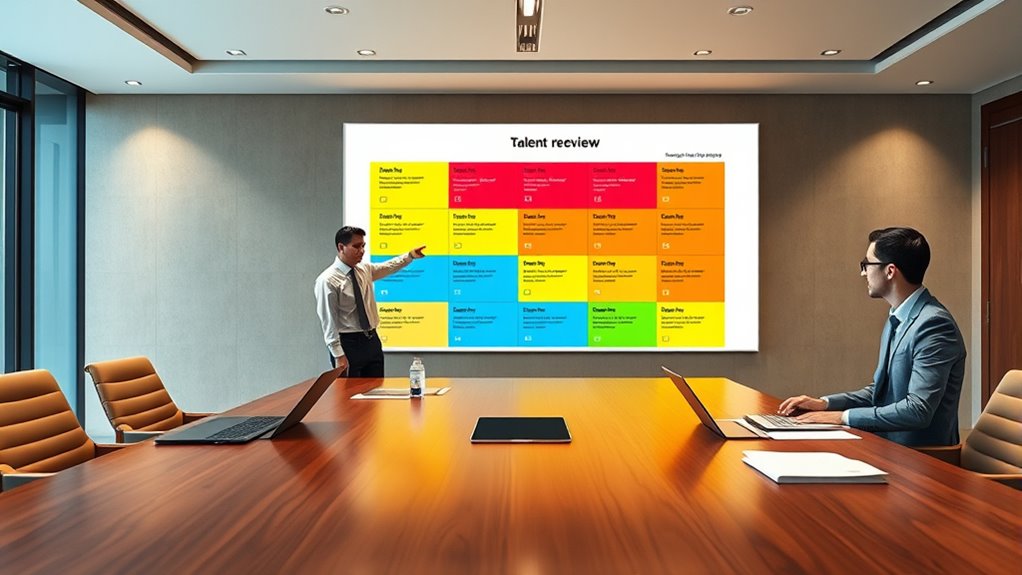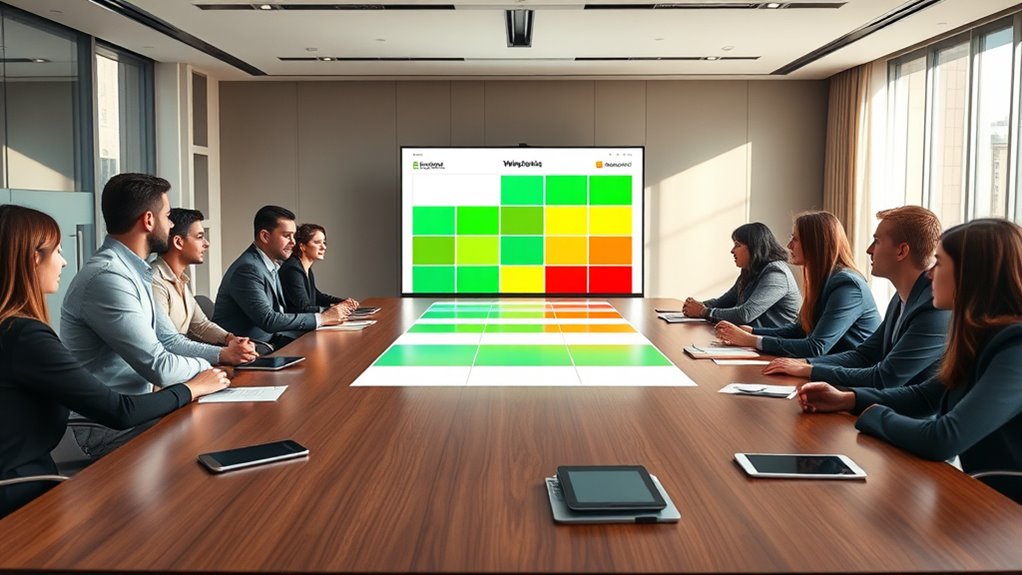Talent reviews and the 9-box grid help you identify, evaluate, and develop high-potential employees by visualizing performance and potential. They support strategic succession planning, promote fair, data-driven decisions, and guarantee your leadership pipeline stays strong. Regular updates keep assessments current, while clear visualizations align talent development with organizational goals. Continuing to explore this process will reveal how these tools can power your talent strategies and strengthen your leadership bench.
Key Takeaways
- The 9-Box Grid visually assesses employee performance and potential to identify high-potential talent.
- Talent reviews using the 9-Box support succession planning and targeted development strategies.
- The process promotes objective, data-driven talent evaluations, reducing subjective biases.
- Regular updates to the 9-Box ensure talent insights reflect current performance and growth.
- Integrating the 9-Box into talent reviews enhances organizational leadership readiness and pipeline resilience.

Talent reviews are a critical part of identifying and developing high-potential employees, and the 9-box grid is a widely used tool to visualize and assess talent. When you conduct talent reviews, you’re not just evaluating current performance; you’re also planning for future leadership needs. The 9-box grid helps you map employees based on their performance and potential, which is essential for effective succession planning. By placing employees into different boxes, you can quickly see who’s ready for promotion, who needs development, and who may be better suited for lateral moves. This structured approach guarantees that your talent pipeline stays robust, with clear pathways for growth and succession.
Talent reviews and the 9-box grid are essential for identifying high-potential employees and ensuring a robust succession pipeline.
Using the 9-box grid promotes a strategic approach to leadership development. It allows you to identify high-potential employees early, giving you the opportunity to design personalized development plans. For leaders, this means focusing resources on those who can fill critical roles in the future. When you integrate the grid into your talent review process, you create a visual snapshot of your organization’s leadership bench strength. This transparency helps leaders and HR teams align on priorities for talent development and succession planning, reducing the risk of leadership gaps down the line.
You’ll find that the 9-box grid also facilitates honest, data-driven conversations about talent. Instead of relying solely on subjective impressions, you can base your assessments on observable behaviors and measurable outcomes. This objectivity improves decision-making, ensuring that you’re investing in the right employees. When you’re planning for leadership development, this clarity is invaluable. It allows you to identify those who need targeted coaching, stretch assignments, or additional training to prepare them for future roles.
Moreover, the grid emphasizes the importance of ongoing talent reviews. It’s not a one-time exercise but rather a dynamic process that reflects changes in employee performance and potential over time. Regular updates ensure your succession planning remains current and flexible, accommodating organizational shifts and individual growth. Additionally, integrating insights from security zone info can help organizations protect high-potential employees and critical talent assets, ensuring a secure and resilient leadership pipeline. By continuously refining your talent map, you can proactively address gaps and accelerate development for those with the highest potential.
Frequently Asked Questions
How Often Should Talent Reviews Be Conducted?
You should conduct talent reviews at least annually, but consider your organization’s size and goals for maximum review scheduling. Frequency considerations depend on how dynamic your workforce is—more frequent reviews, like semi-annual or quarterly, help identify development needs quickly. Regular check-ins ensure you stay aligned with talent development plans, allowing you to address gaps promptly and support your employees’ growth effectively.
What Are Common Pitfalls of Using the 9-Box Grid?
Think of the 9-box grid as a map, but beware—the terrain is easy to misjudge. You might fall into the pitfalls of subjectivity bias, where personal opinions distort assessments, or oversimplification pitfalls, reducing talent to mere categories. These mistakes can lead you astray, making it hard to recognize true potential. To avoid this, stay objective, gather diverse input, and remember that talent is a nuanced journey, not just a grid point.
How Do You Ensure Unbiased Assessments in Talent Reviews?
To guarantee unbiased assessments, you need to focus on bias mitigation and assessment consistency. You can do this by standardizing evaluation criteria and training reviewers to recognize their own biases. Encourage diverse perspectives during reviews and use data-driven insights to support decisions. Regularly calibrate ratings across teams to maintain consistency, and foster an open environment where feedback is constructive, helping you make fair and objective talent assessments.
Can the 9-Box Grid Be Adapted for Different Industries?
Think of the 9-box grid as a chameleon, easily adapting to different environments. You can customize it for various industries by adjusting the criteria for performance and potential, making it a versatile tool across sectors. With industry customization and cross-sector adaptability, you guarantee the grid reflects unique business needs, fostering more accurate talent assessments. This flexibility helps you make smarter decisions, regardless of industry nuances or organizational goals.
What Training Is Recommended for Managers Using the 9-Box Grid?
You should pursue training that emphasizes leadership development and bias mitigation to effectively use the 9-box grid. Focus on workshops or coaching sessions that help you recognize unconscious biases, improve your assessment skills, and develop fair, objective evaluations. This training enhances your ability to make informed talent decisions, fosters equitable practices, and guarantees that your use of the grid supports overall organizational growth and diversity.
Conclusion
As you navigate talent reviews with the 9-box grid, envision each employee as a crucial star in your organization’s constellation. When you accurately assess their potential and performance, you’re guiding them toward the brightest paths. Remember, your insights light the way, helping talent soar or grow stronger. With clear, honest evaluations, you create a galaxy where every individual shines, fueling your team’s success and illuminating your leadership journey.








